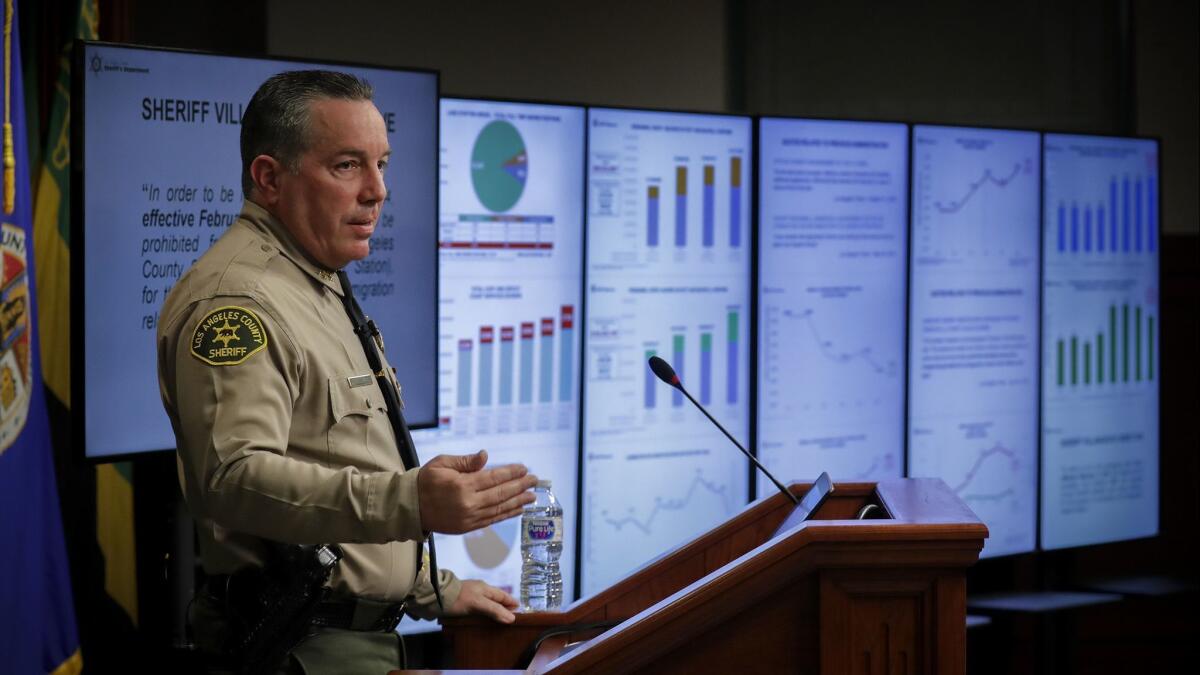Sheriff Villanueva is using faulty data to claim jail violence is rising

Los Angeles County Sheriff Alex Villanueva says the jails he now supervises are a dangerous mess: Inmates increasingly are assaulting one another, staff members are suffering more attacks and use of force has gone way up. He also says that his immediate predecessor, Jim McDonnell, covered up data on the jail violence in order to hide the problem from the public.
But many of the numbers Villanueva is using to make his case are known to be unreliable.
After The Times revealed that the Sheriff’s Department was releasing inconsistent numbers for inmate-on-inmate assaults, the county’s inspector general in 2017 launched a review that found the department lacked a standardized tracking method, the same deficiency criticized by the Citizens’ Commission on Jail Violence years earlier. Outdated software systems sometimes undercounted assaults and at other times made duplicate entries.
Although some of the real numbers of incidents during the past several years are unknown, several watchdogs who spend time inside the jails say they do not believe the lockups are more turbulent overall, and that the most violent uses of force by deputies — resulting in bone-breaking injuries — have dropped significantly.
But Villanueva is using the faulty data anyway, as well as ignoring factors that could account for a rise in reports of use of force, such as stronger reporting procedures.
At a news conference a few weeks ago, he presented charts showing inmate-on-staff assaults shot up 204% from 2013 to 2018 and inmate-on-inmate assaults rose 31% over the same period. Department data in both those categories for 2017 and earlier are inaccurate, said Daniel Baker, the chief deputy for the county’s Office of Inspector General. After his office’s review, the department streamlined some of its systems.
Villanueva also claimed that an executive working under McDonnell had told staff members to stop counting assaults that involve the flinging of bodily fluids, also known as gassings. And he said officials with the prior administration told deputies they weren’t allowed to defend themselves, a problem he says led to instability in the jails.
Those allegations prompted Richard Drooyan — the court-appointed monitor who oversees two federal consent decrees in the jails instituted after a corruption scandal centering on inmate abuse — to request Villanueva provide documents and other evidence. He reminded the sheriff that any changes to the settlement agreements, which inform many use-of-force policies, must be reviewed and ultimately approved by the court.
Villanueva did not respond directly to questions from The Times.
However, in a statement, the sheriff said that he hasn’t changed or rescinded any department policies. Instead, he said, he was reevaluating them “in order to address the threat of growing violence within the jail system.”
“We will continue to work with federal monitors to ensure all mandates and provisions are implemented in a manner to ensure full compliance. The department will continue to provide critical information to the public, which underscores my commitment to transparency,” he said.
Villanueva, who scored an upset over McDonnell in last year’s election, spent much of his career as a street cop who struggled to be promoted and periodically clashed with his superiors over disagreements about how the department should be run.
Now that he’s sheriff, he has made it a priority to challenge some of the reforms implemented after the jail abuse scandal that led to the convictions of former Sheriff Lee Baca and 21 other department officials. He’s talked of reintroducing metal flashlights in the jails so that deputies can defend themselves. He’s warned that riots or killings could happen if the jail atmosphere doesn’t calm down, saying the reforms have resulted in unfair treatment of deputies and made the jail system more violent.
“The conditions are destabilizing,” he said of the county jail system during the address last month. “It’s a dangerous place. People don’t want to be here. Inmates are scared to be here. Our volunteers are afraid to work there. I have nurses who have to endure a gantlet of sexual battery just to get their jobs done.”
Some critics of the department say they’re concerned that Villanueva does not want to continue with the reforms and has embraced a narrative of increasing jail violence in order to justify his position.
“What really worries me is he’s sending a message to [the deputies’ union] and Sheriff’s Department employees that you can go back to the bad old days and you can behave the way the deputies were behaving in the jails before, which was to rule the place with brutality and excessive force on a widespread basis,” said Peter Eliasberg, chief counsel for the ACLU of Southern California, which has been a vocal critic of jail violence.
The organization helped expose abuse in the county’s lockups and regularly sends staff members to monitor conditions there. Eliasberg said he has “zero confidence” in the statistics Villanueva presented, but said there’s no question that severe injuries inflicted on inmates by deputies have dropped significantly.
Others caution that violence is still a major concern in the jails.
Lex Steppling — director of campaigns and policy at Dignity and Power Now, a group that advocates for inmates and their families — said it would be foolish to believe that the reforms, while well-intended, have fully transformed the custody setting.
“Someone saying that the jails are out of control is like saying the sky is blue. The L.A. County jails have never not been out of control,” Steppling said. Still, he said he found it troubling that Villanueva has talked of arming deputies with flashlights as a solution — given their history of being used to brutalize people in jail.
According to Drooyan, Villanueva and his chief of staff, Larry Del Mese, asserted in a recent meeting that they believed the McDonnell administration had engaged in a conspiracy to conceal the true numbers showing a rise in jail violence.
But in his letter to the sheriff last week, the court-appointed monitor said he did not believe he had been misled, noting that his team had worked collaboratively with the department and were never denied information. Drooyan also asked to see documents that Villanueva says show deputies had been ordered not to defend themselves and to stop counting gassings.
As of Wednesday he had not received a response.
In an interview, Drooyan said there was nothing in the reforms he helps oversee that says deputies cannot defend themselves against attacks by inmates.
“To the extent that what [Villanueva] is saying is that the jails have become a much more dangerous place as a result of the reforms, and therefore we cannot continue to adhere to the reforms, that is a cause of great concern to me,” Drooyan said.
McDonnell also rejected Villanueva’s claim that there was a conspiracy to mislead the monitors or anyone about jail statistics.
“I don’t know where he would come up with anything like that,” McDonnell said. “Everyone was working collaboratively together toward reform.”
Deputy groups, however, agree with some of Villanueva’s concerns.
Det. Ron Hernandez, president of the Assn. for Los Angeles Deputy Sheriffs, which endorsed Villanueva’s candidacy and contributed $1.32 million to support him, said he believes that lower staff numbers and increased scrutiny of deputies have contributed to instability in the jails.
“In the past, if you saw two inmates take a fighting stance, you were more inclined to jump in and break it up. But now if you have to touch somebody, that’s viewed as force, so now you almost have to be reactive as opposed to being proactive,” he said.
During his address, Villanueva displayed a chart showing that in 2013, there were nearly the same number of assaults on staff as uses of force by deputies. The graph showed both those categories increasing and diverging so that by 2017, it appears there were more than twice as many assaults on staff as uses-of-force — a problem Villanueva attributed to deputies being told not to defend themselves.
But that could be misleading because it’s based on unreliable data, watchdogs said.
In addition, said former Assistant Sheriff Kelly Harrington, who oversaw the jail system under McDonnell, use-of-force numbers have actually increased under the reforms because the reporting mechanisms were strengthened.
In the past, Harrington said, deputies may have not reported minor uses of force, such as tugging on the arm of an inmate who was wandering astray. Now there is a mandate to document those actions. The installation of cameras inside the jails also created more accountability in writing use-of-force reports, he said.
Harrington said a changing jail clientele that includes more violent offenders and more mentally ill inmates led to more cases of deputies using minor or medium force.
“I can assure you that the Office of Inspector General and the federal monitors would have noticed if we were trying to cook the books in order to favor ourselves in some way,” Harrington said.
Twitter: @mayalau
More to Read
Start your day right
Sign up for Essential California for news, features and recommendations from the L.A. Times and beyond in your inbox six days a week.
You may occasionally receive promotional content from the Los Angeles Times.







